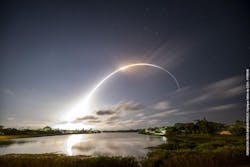Airbus announces successful launch of ESA's Copernicus Sentinel-2 earth observation satellite
KOUROU, French Guiana - Airbus in Toulouse, France announced that the third Copernicus Sentinel-2 satellite has successfully been launched from the European Space Agency's (ESA) site in Kourou, French Guiana. The Airbus-built Sentinel-2C satellite will enter service in low Earth orbit at 780 km following initial testing and commissioning. It will replace Sentinel-2A, which will retire and operate in tandem with Sentinel-2B.
The Sentinel-2 mission consists of two identical satellites in orbit 180 degrees apart, ensuring optimal coverage and revisit times. These satellites complete an orbit around the Earth every 100 minutes, covering all land surfaces, large islands, and both inland and coastal waters every five days.
Sentinel-2C, the latest addition, will provide "color vision" for the Copernicus program. Like its predecessors, Sentinel-2A and -2B, it will deliver optical images across the visible to short-wave infrared spectrum. Weighing 1.1 tons, the satellite offers imaging in 13 spectral bands with resolutions of 10, 20, or 60 meters per pixel and a broad swath width of 290 kilometers.
Data from the Sentinel-2 satellites support a range of applications including land use monitoring, soil sealing, land management, agriculture, forestry, and disaster response like floods, forest fires, landslides, and erosion. They also aid in monitoring coastal environments, glaciers, ice, and snow.
Each satellite produces 1.5 terabytes of data daily, which is compressed and temporarily stored on board. Data is then transmitted quickly via the EDRS SpaceDataHighway and X-band links to ground stations.
The Sentinel satellites are part of Copernicus, the Earth Observation component of the EU Space Programme, overseen by the European Commission in collaboration with the European Space Agency. They provide essential remote sensing data for environmental and security-related services.
Marc Steckling, Head of Earth Observation, Science, and Exploration at Airbus, said: “This launch gives the world another important sensor to monitor our changing planet and provides crucial continuity since the first Sentinel-2 satellite launch in 2015. Equipped with a high-resolution multispectral imager, the satellite will collect vital imagery for a myriad of applications from agriculture to water quality monitoring.”
